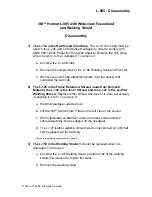
TBL
1
S
Transformer Balanced
Line Input Module
Features
• Transformer-isolated line level input
• Gain/Trim control
• Bass and treble
• Audio Gating
• Gating with threshold and duration adjustments
• Variable signal ducking when muted
• Fade back from mute
• 4 levels of available priority
• Can be muted from higher priority modules
• Can mute lower priority modules
• Pluggable screw terminal strip
600/10K
GATE
ENABLE/
DISABLE
BUS
ASSIGNMENT
BUS A
BUS B
Printed in Taiwan.
© 2007 Bogen Communications, Inc.
54-2084-0
1
D 0704
Specifications subject to change without notice.
50 Spring Street, Ramsey, NJ 07446, U.S.A.
201-934-8500; Fax: 201-934-9832
www.bogen.com
Block Diagram
Input Wiring
Balanced Connection
Use this wiring when the source equipment
supplies a balanced, 3-wire output signal.
Connect the shield wire of the source signal
to the “G” terminal of the input. If the “+”
signal lead of the source can be identified,
connect it to the plus “+” terminal of the input. If the source lead polarity cannot be identified,
connect either of the hot leads to the plus “+” terminal. Connect the remaining lead to the minus
“-” terminal of the input.
Note:
If polarity of the output signal versus the input signal is important, it may be necessary to
reverse input lead connections.
Unbalanced Connection
When the source device provides only an
unbalanced output (signal and ground), the
input module should be wired with the "-"
input shorted to ground (G). The unbal-
anced signal's shield wire is connected to
the input module’s ground and the signal
hot wire is connected to the "+" terminal. Since unbalanced connections do not provide the same
amount of noise immunity that a balanced connection does, the connection distances should be
made as short as possible.





















